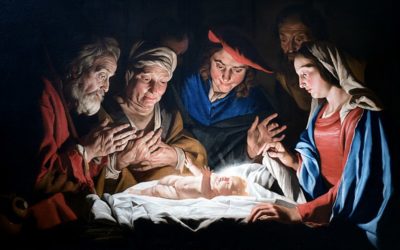This week’s Come, Follow Me lesson looks at sections 27 and 28 of the Doctrine and Covenants, which provide further direction to the fledgling Church of Christ on a host of matters ranging from sacramental emblems and the Second Coming through priesthood restoration, who can receive revelation for the Church, and the first long-range mission.
Doctrine and Covenants 27
Like section 20, section 27 of the Doctrine and Covenants is an excellent example of line-upon-line, precept-upon-precept, revelation. As the current headnote to the section explains, part of the revelation “was written at the time [August 1830] and the remainder in the September following.”
Part 1: Sacramental Emblems
The part written in August 1830 dealt specifically with the question of what elements should be used in the sacrament. One of the earliest copies of the revelation begins with the explanation, “A Revelation to the Church given at Harmony susquehannh County State of Pennsylvania given to Joseph the Seer at a time that he went to purchase wine it for Sacrament & he was stoped by an Angel & he he spok to him as follows Saying.”
Joseph Smith’s history explains that in August 1830, his friends Newell and Sally Knight came to visit him and Emma at their home in Harmony, Pennsylvania. Neither Emma nor Sally had yet been confirmed members of the Church. Besides carrying out the confirmations, the group decided to hold a sacrament service together before the Knights left.
As in many other churches, the Church of Christ at this time used wine for the sacrament, as specified in the Articles and Covenants of the Church (Doctrine and Covenants 20:79) and Moroni 5:2 in the Book of Mormon. Not having any wine on hand, Joseph went out to procure some, met the angel, and received the word of the Lord from him on the subject.
The Lord through the angel declared, “It mattereth not what ye shall eat or what ye shall drink when ye partake of the sacrament, if it so be that ye do it with an eye single to my glory—remembering unto the Father my body which was laid down for you, and my blood which was shed for the remission of your sins” (verse 2).
Some Church members today wrongly assume that this revelation ended the use of wine for sacrament services. But nothing in the revelation forbade it, and wine continued to be used when available and affordable, provided it met the revelation’s requirement that it be “made new among you; yea, in this my Father’s kingdom which shall be built up on the earth” (verse 4).
The Joseph Smith Papers website points out, “In 1833, John Murdock and members of the church in New York where he was preaching made their own wine for this purpose. He recalled that ‘by my advice the Sisters gathered currents & made wine for our communion.’” Later, in southern Utah, many of the Saints grew wine for sacramental use and as a cash crop. Use of wine in the sacrament largely died out in the early twentieth century as the Word of Wisdom went from counsel to commandment. (We’ll say more about this when we reach section 89.)
As the headnote to section 27 explains, “Water is now used instead of wine in the sacramental services of the Church.” In the absence of bread, Church members have substituted local equivalents, such as crackers or tortillas, in the sacrament. The General Handbook specifies the use of “bread and water,” with the exception of “allergen-free bread or another broken bread-like substitute” if necessary “to ensure the health and safety of a particular member.”
For an early text of the first part of section 27, click here. For further historical information on this portion and the entire section, click here.
Part 2: Line Upon Line Expansions
After the first portion of the revelation was received, Joseph Smith received additional inspiration that expanded the text considerably in two places, adding to our understanding of the Second Coming, explaining some of Joseph’s early spiritual experiences, and providing admonitions regarding the armor of God. The expansion may have occurred in September 1830, a short time after the first portion was received, though the earliest surviving text dates to about August 1835 in the first edition of the Doctrine and Covenants. For more on the addition and its history, click here.
Details on the Second Coming
The first insertion occurred after the words “on the earth” in verse five and included the remainder of that verse and all the verses from there down to and including the first two words of verse 14. This insertion mentions many of the important spiritual figures who will be present to partake of “the fruit of the vine” with Christ at his Second Coming. These include Moroni, Elias, John the Baptist, and Elijah (verses 5–9). Moroni and John the Baptist had already visited Joseph, and Elias and Elijah would appear in the Kirtland Temple in 1836 (which we will discuss with section 110). They also include the famous four generation of Old Testament patriarchs Abraham, Isaac, Jacob, and Joseph (verse 10), as well as “Michael, or Adam, the father of all, the prince of all, the ancient of days” (verse 11). And they include the New Testament apostles Peter, James, and John (verse 12).
Priesthood Restoration
Each of the persons named as attending is also described for his spiritual significance. The mention of Elias and Elijah presages the bestowal of keys in 1836. The mention of Peter, James, and John in verses 12 and 13 is important because details of the Melchizedek Priesthood restoration are scarce.
For “links or citations to the earliest records describing or alluding to the restoration of authority and priesthood,” click here.
The Whole Armor of God
The second expansion occurs after “gird up your loins” in verse 15 and concludes with “whatsoever ye ask of me, and” in verse 18. This addition echoes what Ephesians 6:13–17 says about putting on God’s whole armor but with important variations. For example, Ephesians 6:15 reads, “And your feet shod with the preparation of the gospel of peace,” but Doctrine and Covenants 27:16 expands “gospel of peace” to read “gospel of peace, which I have sent mine angels to commit unto you.” Ephesians 6:17 says to take “the sword of the Spirit, which is the word of God.” Doctrine and Covenants 27:18 says to take “the sword of my Spirit, which I will pour out upon you, and my word which I reveal unto you.”
Doctrine and Covenants 28
For there to be order in the newly established Church of Christ in 1830, someone had to be in charge. At a time when there was not yet a Church President, First Presidency, Quorum of the Twelve, Quorums of Seventy, Presiding Bishopric, or other positions familiar to Latter-day Saints today, the question of who was in charge became very real. That was particularly true because the Church was small, and many of its key members were relatives.
Officially, Joseph Smith was the first elder and Oliver Cowdery the second elder, meaning they could have seen themselves as peers. Oliver probably saw himself as superior when it came to writing and speaking. The early Church members included the Smiths, Whitmers, Knights, and their relatives. Hiram Page, one of the Eight Witnesses to the Book of Mormon, was married to Catherine Whitmer, daughter of Peter Sr. and Mary. Oliver Cowdery would eventually marry Catherine’s sister Elizabeth Ann.
In this tightknit environment, it is no surprise that disagreements occurred from time to time, and Doctrine and Covenants 28 helped resolve two disputes and led to a very important mission.
Dispute 1: Oliver Tries to Command Joseph
Oliver Cowdery got upset at Joseph over a verse in the Church Articles and Covenants (section 20) and commanded Joseph to eliminate it. For more background in this dispute, click here.
In section 28, verses 1 through 7, the Lord kindly corrects Oliver, telling him the many positive things he can do as second elder and directing him not to command Joseph Smith, who is the head of the Church and the only one entitled to receive revelation for the whole.
Dispute 2: Hiram Page’s Seer Stone
The early members of the Church knew that Joseph had translated the Book of Mormon with the help of the two stones in silver bows, later referred to at the Urim and Thummim, as well as other seer stones. Perhaps it is not surprising, then, that when Hiram Page began to claim revelations through a seer stone, some members of the Church believed him. But receiving revelation for the Church was not Hiram’s responsibility.
Section 28, verses 11 to 14, tell Oliver to quietly meet with Hiram and explain his folly, which Oliver does, again following the principle that only the Prophet can receive revelation for the whole Church.
For additional historical background, click here.
For biographical information on Hiram Page, click here and here.
A Mission to the Lamanites
Although many of the early Church members had preached the gospel in their neighborhoods and surrounding areas, Joseph’s brother Samuel among them, there had not yet been a missionary assignment that required very long travel until the Lord in section 28 called Oliver Cowdery to “go unto the Lamanites and preach my gospel unto them” (verse 8). Oliver would later be assigned companions (whom we’ll discuss when we get to section 32).
This missionary assignment would have enormous long-term implications for the Church. The mission to Missouri would help “chart the course the fledgling Church would follow during the coming decade.”
Photo credit



